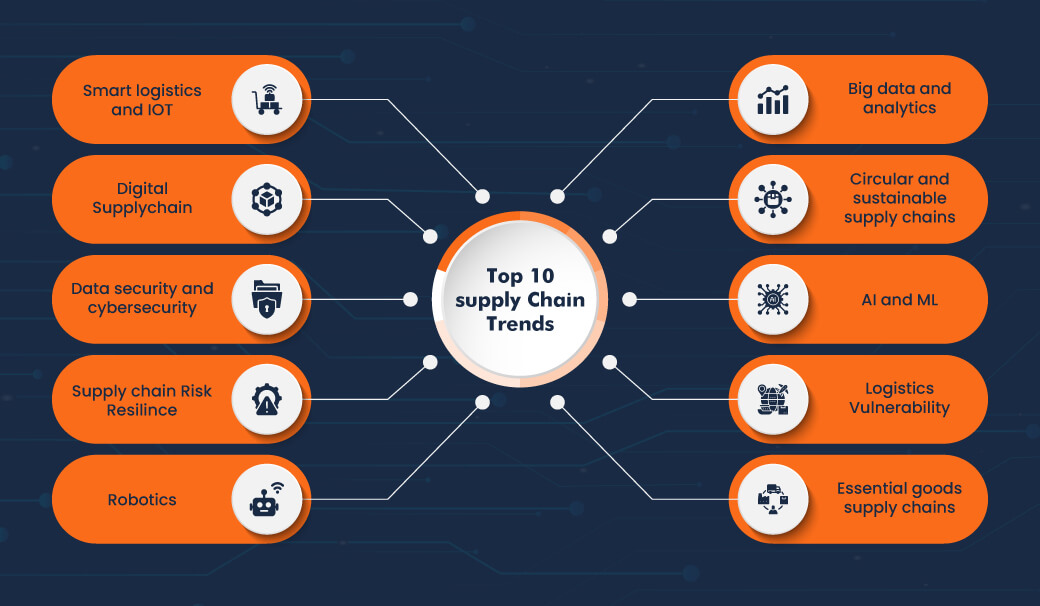Supply chain management (SCM) is an essential element of modern businesses and has a critical impact on their success or failure. In the upcoming years, we expect to witness numerous emerging trends in supply chain management that will redefine how businesses function and compete. The global supply chain is undergoing rapid evolution, keeping up with the rapid technological advancements of today's era. While it may be challenging for supply chain managers and business leaders to keep abreast of these developments, it is crucial to do so in order to uphold supply chain resilience and amplify business success. In this article, we will examine the prominent trends in supply chain management (SCM) that are expected to shape the industry in 2023.
The Top 10 Supply Chain Management Trends

The field of supply chain management (SCM) is continuously evolving to adapt to the ever-changing business landscape. As we look ahead to 2023, several key trends are set to shape the future of SCM. These trends are driven by technological advancements, changing customer expectations, and the need for organizations to remain agile and resilient. Now, we will be expected to dominate the world of supply chain management trends in 2023. From digital transformation to sustainability initiatives, these trends will have a significant impact on how businesses operate and compete in the global marketplace. Let's delve into these trends and uncover how they are set to transform supply chain management practices in the coming year.
1. Big data and Analytics
The utilization of big data and analytics is empowering organizations to effectively manage disruptions through digital and agile supply chain management. By implementing predictive and prescriptive analytics and leveraging advancements in big data, algorithms, and robotics, businesses can experience significant benefits. These include enhanced visibility, synchronized planning and execution, data-driven decision-making, predictability, agility, and improved profitability. Embracing these solutions allows organizations to navigate uncertainties and drive success in an ever-changing business landscape.
2. Digital supply chains
The emerging trend in supply chain management is that digital supply chains will remain integral to various trends, including risk management, resilience, and security. The successful digitization of supply chains entails the widespread deployment of sensors through the Internet of Things (IoT), the adoption of digital twins, the utilization of shared internal and external interfaces like cloud-based networks, and the automation and verification of processes. Organizations that excel at embracing these digital supply chain capabilities will outperform competitors by being more agile and efficient. Failing to adopt these advancements may result in falling behind agile and more efficient rivals in the industry.
3. Supply chain risk and resilience
Collaboration among intricate and interconnected global networks is vital for managing supply chain risks and building resilience. Key strategies include supplier diversification, production capacity diversification, and alternative transportation processes. Additionally, exploring alternative materials and forming nontraditional partnerships can contribute to resilience. Many supply chains are expected to become more compact and localized. Designing resilient supply chains will be crucial for swiftly mitigating adverse events, delivering exceptional customer service, creating value, capturing market share, and outpacing competitors.
4. Artificial intelligence and Machine learning
Artificial intelligence (AI) and machine learning (ML), key elements in several trends in supply chain management are increasingly playing a central role in optimizing and enabling systems through their interoperability across diverse business domains. They serve as the foundation for integrating people, processes, and systems across various operational environments. The evolution towards an industry driven by technology, emphasizes a more collaborative approach and fosters partnerships between humans and robots, greatly influencing numerous functions within the supply chain.
5. Robotics
Robotics is a supply chain management trend in which organizations are increasingly turning to robotics in response to labour shortages, supply disruptions, and increased demand. Intelligent robotics are revolutionizing supply chains, driven by the combination of rapid technological advancements and improved affordability. Both mobile and stationary robots are being employed to assist workers in various tasks such as warehousing, transportation, and last-mile delivery. By creating safer and more efficient warehouses with reduced human presence, costs can be significantly reduced. While the initial capital investment for implementing robotics may be high, the potential cost savings are expected to be substantial.
6. Data security and cybersecurity
As digital supply chains continue to advance, the risk of cyberattacks on their global networks increases. The interdependence among supply chain partners can lead to unintended exposure to privacy breaches, identity theft, and other serious consequences for both partners and customers. Expect a rise in collaborative efforts to protect networks, devices, individuals, and software programs. Furthermore, organizations will increasingly opt to allocate resources towards redundancy, firewalls, advanced anti-hacking technologies, and employee training to enhance their security measures.
7. Circular and sustainable supply chains
The traditional linear business model based on the principles of extraction, production, and disposal is unsustainable for the planet, leading to higher costs of raw materials and a greater risk of shortages and instability. Additionally, access to rare minerals, energy, and commodities often becomes a source of conflict and war. Given the extensive reach of supply chains across our global ecosystem, it is crucial and holds immense significance to transition towards circular economies that prioritize responsible practices, restoration, and regeneration.
8. Essential goods supply chains
Supply chain future trends are to ensure the smooth flow of products, supply chain managers play a crucial role in supporting essential goods producers, facilitating surplus distribution to humanitarian organizations, and facilitating connections between retailers, governments, and non-governmental organizations with capable suppliers. Furthermore, the growth of temperature-controlled goods fulfilment presents new obstacles in terms of accurate picking, packaging, and transportation, necessitating special procedures, innovative cold-chain packaging, and optimized infrastructure to maintain temperature integrity throughout the supply chain.
9. Smart Logistics and the Internet of Things
In the realm of supply chain management trends, having valuable insights and agility emerge as crucial competitive advantages. The Internet of Things (IoT) plays a pivotal role in this regard by offering almost real-time visibility and information regarding the location of products, their movement speed, estimated arrival times, and local atmospheric conditions. This serves as the basis for smart logistics, as it sheds light on delays, disruptions, and potential quality issues. The valuable insights obtained through IoT enable organizations to reduce costs, enhance service levels, and optimize their networks.
10. Logistics vulnerability
Efficient transportation planning systems heavily depend on collaborative and adaptable efforts from all supply chain stakeholders. This collaboration allows them to dynamically adjust their transportation modes based on up-to-date information. The advantages of such an approach include enhanced visibility, integration, and flexibility. To achieve this, logistics organizations need to establish an environment that facilitates seamless interaction between multiple transportation networks and their digital counterparts. Additionally, they should reassess the physical connections between warehouses, highways, ports, waterways, and air transportation to ensure optimized logistics operations in the context of trends in supply chain management.
Conclusion
In the future, the strategy of supply chains will be influenced by various factors, such as the ongoing growth of e-commerce, the influence of technology, the need for sustainability, the significance of data and analytics, and the effects of inflationary pressures. Organizations capable of adjusting to these trends and formulating efficient supply chain strategies will be in a favourable position to thrive in a dynamic and evolving business landscape.
To maintain competitiveness, it is crucial to adopt a comprehensive and integrated strategy that considers these trends. As the business environment continues to transform, organizations must proactively adapt to evolving customer demands and industry requirements. By developing and executing appropriate strategies, companies can not only survive but also excel in this new landscape, positioning themselves as the frontrunners in the market of the future.
 Translate
Translate


















Author Bio
Sivabharathy
Lead Project Manager
Sivabharathy is a technical architect, technology enthusiast, and voracious reader. His visionary perspective has earned him opportunities to work with innovative projects in the computer software industry. He is an expert in PHP, JavaScript, NodeJS, Angular, Ethereum, Web3, Product Development, and Teamwork.